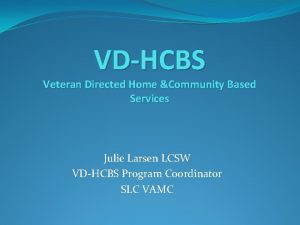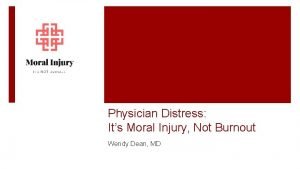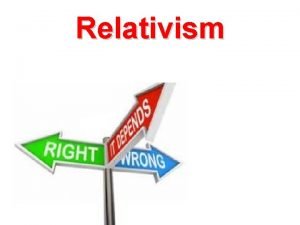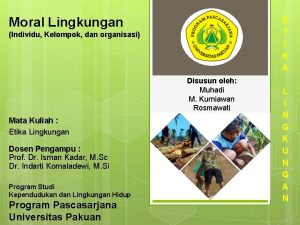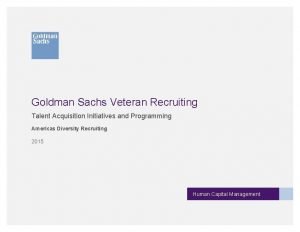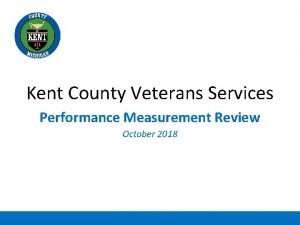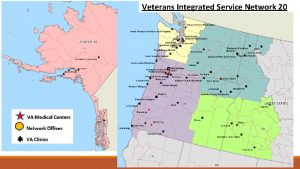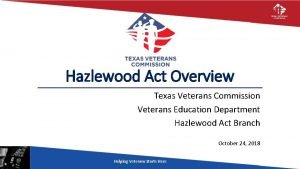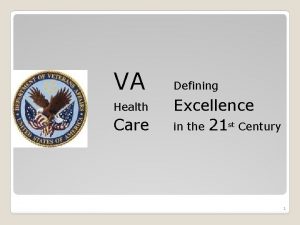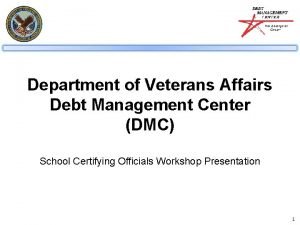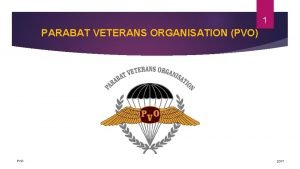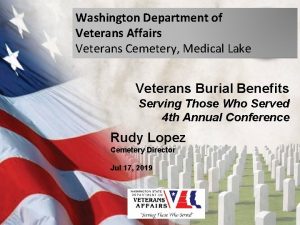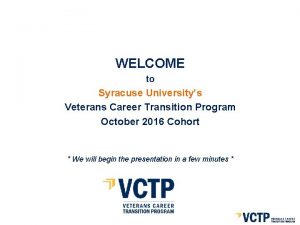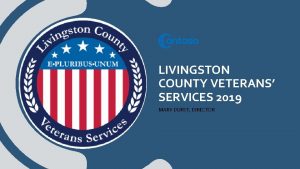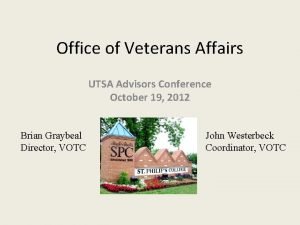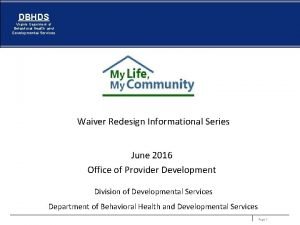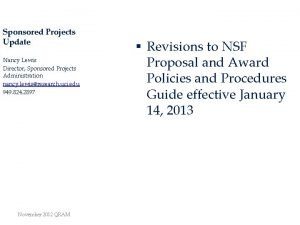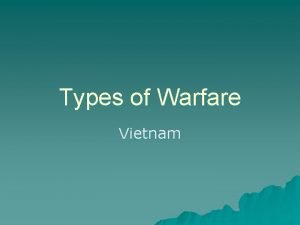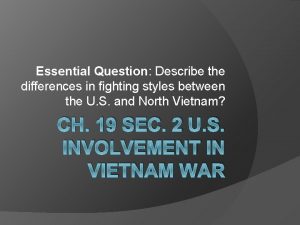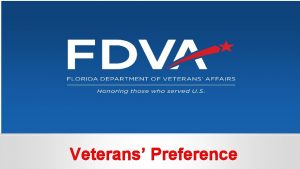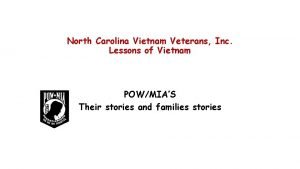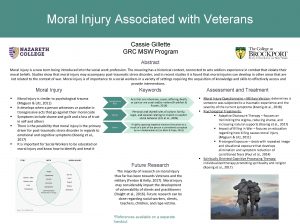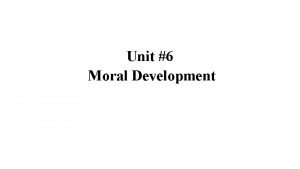Community Hospices Moral Injury in Vietnam Veterans Sponsored































































- Slides: 63

Community Hospices: Moral Injury in Vietnam Veterans Sponsored by the Empowering Community Hospices Initiative

Course Objectives After taking this course, participants will be able to: • Describe Moral Injury (MI) • Identify how Moral Injury develops • Understand the similarities and differences between Post Traumatic Stress Disorder (PTSD) and Moral Injury • Describe how Moral Injury affects Vietnam Veterans at the end of life • Understand how to care for Vietnam Veterans with Moral Injury at the end of life

Course Outline • • Vietnam Cohort Risk Factors What is Moral Injury? How are MI & PTSD different? Moral Injury approaches • Stress First Aid • Treatment • Case study for discussion

Social burden of reintegration producing a code of silence and suppressed memories Agent orange Immunizations Occupational health exposures and aging Refusal to engage the Veteran’s Administration even if they have service connected disability Viet Nam Veteran Cohort: Unique Risk Factors Prophylaxis for tropical disease Above average alcohol and substance abuse Stress loaded occupations and social behaviors

Events are considered morally injurious if they transgress deeply held moral beliefs and expectations which shatters moral and ethical expectations that are rooted in religious or spiritual beliefs, or culture-based, organizational, and group-based rules about fairness, the value of life, and so forth…. Moral Injury describes the harmful psycho-spiritual aftermath of exposure to such events. What is Moral Injury?

Moral Injury • Less likely to be related to lifethreatening events • Spiritual Focus • Identity Focus • Avoidance: wish to protect others • Less Research • Less Consensus • Narrower Focus Moral Injury / PTSD Symptom Overlap Reminders Avoidance / Denial Intrusive Thoughts Sleep Issues Substance Use Negative Cognitions: Guilt/Shame Anger Disgust Betrayal Negative view of self Social problems Trust issues Spiritual changes Fatalism or sorrow PTSD • More likely to be related to lifethreatening events • Reexperiencing • Hyperarousal • Avoidance: preventing re-injury • More research • More consensus • Broader Focus

Soul Injury Moral Injury Focus on violation of deeply held moral beliefs PTSD / Research Narrower Focus Identity Betrayal Negative view of self Social problems Trust issues Spiritual changes Fatalism or sorrow Symptom Alleviation: Compassion, Understanding, Forgiveness Moral Injury / Soul Injury Overlap Focus on violation of personhood Injury against being Hospice surveys Broader Focus

Experiences That Could Produce Moral Injury Perceived betrayal (by peers, leadership, civilians or self) Acts of disproportionate violence inflicted on others Engaging in or witnessing acts that violated personal moral beliefs Incidents involving death or harm to civilians Within ranks violence Wishing you had done something that you didn't do

Some Veterans feel guilty for NOT killing, or for enjoying killing Some have to forgive comrades for unjustifiable acts that the Veteran felt powerless to confront Moral Injury Guilt Examples in Veterans Noncombat veterans sometimes feel guilty when they have seen fellow soldiers volunteer for dangerous missions Nurses and medics may feel guilty about the life and death decisions they made Survivor’s guilt is common; it can interfere with Veterans’ ability to enjoy their lives Others have guilt for killing women and children or committing “friendly fire” or intentional killing of perceived poor leaders Some veterans feel guilty for what they have put their family through

Life Review reopens unresolved emotional and spiritual wounds Moral Injury & Veterans in Later Life Feeling as if they are unable to forgive self or be forgiven Fearing that they are not worthy of redemption Unable to trust anyone to open up about experiences Despair due to loss of life meaning and purpose

When trying to provide a “thank you for your service” ceremony, a Vietnam Veteran’s wife said “don’t you dare come in here and do that – he thought they were coming to recruit him again. ” A Vietnam Veteran with Moral Injury starts to cast away family members at the end of life. A Vietnam Veteran doing a life review casts himself as a murderer and believes death is hell. Because of this, he is not feeling at peace. As combat Veteran gets to the end of life and has a lot of angst. He asks, “Are you sure you want to be with me? I’m a murderer. ” A Vietnam Veteran doesn’t feel understood because hospice staff assume his guilt is related to combat experiences. In reality, in combat he never felt more alive, he was surrounded by his best friends, he lived through it and survived. His moral injury occurred when he came home and felt that he was rejected by the people he was supposed to be protecting. Moral Injury End of Life Examples I

May require too much patient stamina Challenges with Formal Mental Health Treatments in Palliative Care / Hospice Settings May require too much time Can lead to short-term distress and/or increases in symptoms initially Do not address end-of-life issues Have little role for family, caregivers May require modification for aging- and/or illness-related challenges (e. g. , sensory deficits, cognitive impairment)

Stage I Stepped Care Approach to Address Moral Injury in Hospice Care • Assess and palliate the suffering related to moral injury and provide social supports • Enhance coping skills Stage III

STRESS FIRST AID: Stages 1 and 2 in Stepped Care Model

Make a connection in a helpful/respectful way Restore/support a sense of safety Objectives of Stress First Aid Calm and orient distressed individuals Connect individuals to their sources of support Improve the ability of those affected to address their most critical needs Foster a sense of hope/limit self-doubt and guilt 15

Opening Questions Culturally Sensitive Questions Check: Making a Connection Deepening Questions Religion/Spirituality Questions

“What really matters to you in your life? What most concerns you? " “What thought keeps coming back to you? What do you keep telling yourself? ” “How have you been feeling since…? ” “Have you been through anything like this before? How is this similar/different? ” “"How is this affecting how you feel about yourself, your relationships, the world? " Opening Discussion Comments / Questions

I have a few questions that would help me understand more about your experience in the military. May I continue? What was your primary job? What did you do? Where were you been stationed? What kinds of missions did you participate in? What kind of work did you do, and what was your role? How long did you serve? Was there anything you took from your military service into the rest of your life? What are some of the most important aspects of having served in the military? What were some of the biggest challenges about being in the military? What were some of the greatest rewards about being in the military? Have your own values ever caused you to be angry with yourself or others who do not live up to those standards? What aspects of serving in the military influence you now? Military Culturally Competent Questions to Ask a Veteran

Do you think you were changed as a result of being in the military? Please describe the changes. Do you think your experiences in the military are affecting you today? Deepening Questions to Ask a Veteran Is there anything about your experiences in the military that is still troubling you today? Do you have nightmares about the war? What was your homecoming like? Is there anything about your homecoming that is still troubling you today? Do you think your experiences in the military and your homecoming affected your relationships with family and friends? Do you keep in touch with your war buddies? Do you think your experience in the military is influencing the way you are now coping with your illness?

Are you affiliated with a religious or faith community? Religion/ Spirituality Questions to Ask a Veteran Do you see yourself as a religious or spiritual person? If so, in what way? Has your religion or spirituality changed over the years, and if so, in what ways? How does your religion or spirituality influence the way you’ve coped with events in your life? Are they working now?

Stress First Aid Core Actions 1 Cover 2 Calm 3 Connect 4 Competence 5 Confidence 21

Approach • Treat the person with kindness, compassion, respect and nonjudgment Informatio n • Ask about concerns • Give simple, accurate information • Convey that you are there to help and to keep the person safe • Help create a sense of safety where Veterans can disclose their concerns, worries, and struggles about making sense of their life experiences Direction • Protect the person from unnecessary exposure to reminders • Set boundaries to protect them and others • If you have to act firmly or abruptly, moderate the impact at your first opportunity • Reinforce compliance by promptly and positively acknowledging actions that follow your instructions Cover Actions 22

Cover Actions: Moral Injury Samples from the Field Have a conversation about how safe the Veteran feels, such as any concerns they might have about: • Any feelings of loss of control • Confidence level about getting adequate pain relief • Fear of abandonment • Any feeling of a fear of death 23

Approach Calm Actions • • Maintain a calm presence Respect needs Expect and show understanding of emotions Validate Information • Ask questions in calming or distracting way • Use reflection, clarifying statements to communicate that you’ve heard correctly • Provide information about services • Give reassurance • Convey that reactions are understandable without dismissing or minimizing Direction • Emphasize the present, and what’s practical / possible • Use distraction at times • Direct to use simple self-calming actions • Writing • Guided breathing • Guided imagery • Progressive muscle relaxation • Prayer 24 • Meditation

• “What we do and what we say is not as important as what the Veteran says. And what they really want from us is to know that we can tolerate being in their presence as they try to figure out who they are now at the end of life. ” Calm Actions: Moral Injury Samples from the Field • “Be a witness and stand in non-judgment, and just be with them. Bear witness – the story does not need to be true. It is their story. You do not need to act on it if they talk about war crimes. It’s about not passing judgment. ” • “If you don’t know how to respond, say something like: “how very interesting. I’ve never heard that perspective before. ” Or: “I’ve never thought of that experience in that way before. ” Acknowledge what they’ve said. ” • “If you want more information, say something like: “You’ve had such an amazing experience, and it sounds like you’ve experienced some things that nobody should have experienced – help me understand how that's impacting you NOW. ”” 25

Approach • Connect people to trusted supports however possible Information • Get contact information • Look for people in vicinity to connect individuals to • Ask about who are most trusted supports (including pets) Direction • Foster reconnection with family, friends • Encourage peer support with those available • Solicit volunteers to provide support Connect Actions 26

• “Educate families on what Moral Injury is and how it can affect Veterans at the end of life. ” Connect Actions: Moral Injury Samples from the Field • “Help the family have a connection at end of life if they have felt distanced/ostracized. ” • “If family members get jealous of the fact that the Veteran has never told them something that he told you, say something like: “Often it is difficult for Veterans to share their experience with the ones they love because they swore an oath to protect the ones they love. If its’ such a burden for them to bear, why on earth would they do that to the ones they love? ”” • “The family is often trying to figure out who are they in relation to a Veteran when that Veteran is dying. They might still be angry at him, but if they know his experiences, it can diffuse or redirect their anger to the war versus just to the Veteran. ” 27

Connect Actions: Moral Injury Samples from the Field • “If a Veteran is in a coma or unresponsive, you can say something like, “he or she can still hear you. Say whatever you need to say and say it with loving kindness and compassion. Even if you’re angry you can say “I was so angry because I felt abandoned. ”” • “This is the time to consider unfinished business for both the Veteran and their family. If the patient cannot engage, invite the family to share important messages with them. ” • “If a Veteran has shared something with you that they have not shared with their family, you can say something like: “you have shared with me a very amazing story. Thank you for trusting me enough to share it. There are some very important people who want to hear it. You’ve shared it, I think you’re an amazing person. Who in your family would it be okay to tell this story to? ”” 28

Connect Actions: Moral Injury Samples from the Field • “If the Veteran says he can’t possibly talk to his family, you could say something like: “would you be okay if I shared it with them? I can’t possibly tell the story in your words but I can share what I understand that you had an experience of war that changed how you saw yourself and your life, and you have been living with it for the past 50 years. It’s been a long and tiring journey, and you were able to share some of it with me. There are details of the experience that you can’t say again. Saying it once to me may have been enough or too much and I respect that. Is there anything specifically that you want me to share with your family? I’m going to tell your family that they need to tell you that they’ve heard the story from me, and you can decide how you want to continue the dialogue. But I can be a bridge. ”” 29

Relaxation / breathing / sleep training Competence: Stepped Care Stage II: Enhance Coping Skills Thought-stopping skills Mindfulness-based/acceptance skills Communication/social-skills training

Approach • Approach the situation with an eye towards restoring a sense of control and improving the person’s ability to deal with moral injury reactions Information • Determine people’s needs, what your role is, and what else is needed • Provide verbal and written information on coping skills: • Relaxation / breathing / sleep training • Thought-stopping skills • Mindfulness-based/acceptance skills • Communication/social-skills training Direction • Facilitate skills practice and troubleshooting • Get people connected to other resources: • Spiritual care • Clinical Care • Other Veterans (such as Veteran volunteers) • Encourage use of resources 31 Competence Actions

Coping Skills: Mobile Apps

Competence Actions: Moral Injury Samples from the Field • “For the Veteran who feels “I’m dying and I’ve never done this before, ” be prepared to have a conversation about it, about how they want to choose to die, and what their models of death and dying are. ” • “For the Veteran who may feel like he doesn’t know how to talk with his family about his sense of moral injury, help them to understand how to have a conversation that focuses on how that moral injury has affected them in their relationships and how it is affecting them now, rather than having to disclose the circumstances of the morally injurious events. ” 33

Approach • Keep a neutral or positive attitude • Avoid judgment Information • Clarify misunderstandings and distortions • Give information about treatment options • Ask about how they would like to proceed Direction • Focus the person on the present moment or future • Reduce guilt about actions with Confidence strategies Confidence Actions 34

Be careful about the following actions: Statements that imply judgments about what the person could or should have done Statements or questions that can be perceived as accusatory or incriminatory Statements or gestures indicating that you think the person should be reacting differently now Offering possibly inaccurate information, or potentially false hope. If you cannot answer a person’s question, do your best to learn the facts Confidence Alert

Make simple, nonjudgmental statements such as: “I can understand why you’re feeling this way, given your strong values, ” “I know this can be rough, ” “What can I do to help / What would be helpful? ” Help the individual to construct a timeline or narrative with room for personal strengths, positive relationships, spiritual change, appreciation for life, or what is helpful. Help the person examine the double edged sword of their values and beliefs, and focus on the present. Be willing to talk with them as many times as they need, give them relevant reading materials, and connect them to treatment or to people who have dealt with similar things, such as Veteran volunteers. Confidence Suggestions: Moral Injury

Confidence Actions: Moral Injury Samples from the Field • “For the Veteran who fears going to hell, say something like: “Is there anything that would help ease your concern? What is your belief system? Where did you learn about hell? You mentioned fear of going to hell, and that you feel that you have already been there. ” • “You can offer a Chaplain or clergy. This may be a challenge if they are angry at God, in which case Chaplains can become a lightning rod for that anger. Then, you may have to offer a neutral or agnostic volunteer such as another Veteran, to bear witness. If it is you, make every attempt to put your values in neutral. ” • “If you can’t tolerate bearing witness, be honest. Say something like: “I don’t know if I can hear this story, but I know someone who can. I can connect you with a Veteran Service Organization like the VFW, etc. ”” 37

Confidence Actions: Moral Injury Samples from the Field • “Talk about their strengths and vulnerabilities, and about the values they bring. Emotional pain is often an echo of a commitment to core values. Use core values as part of the discussion. ” • “If the Veteran speaks of guilt because of acts of omission, say something like: “It sounds like you’re sad about something you didn’t do? ”” • “If the Veteran speaks about guilt because of acts of commission, say something like: “It sounds like you’re really burdened by things you did, or that you understood that you did. ”” 38

• Don’t try to rationalize away guilt with, “That was a long time ago” or “You were just obeying orders. ” Instead, recognize that they may be seeking forgiveness. • Don’t rebuff apologies with, “It’s okay. You don’t need to apologize. ” Instead, receive the apology openly. • Don’t rush people into forgiveness prematurely. • Beware of “false forgiveness, ” those times when a patient says “I let that go a long time ago” or “It’s over Reexperiencing and forgotten. ” Spiritual Focus Hyperarousal • Wanting to forgive Identity is an essential, Affirmation or prayer can help Focus often forgotten, element of forgiveness. Avoidance Focus achieve this. • Respect the decision a person makes about whether or not to forgive. • If someone is unable, unwilling, or not ready to forgive, patiently wait for another opportunity and ask them More research Less Research to reconsider it. However, be careful that they do not experience any pressure or judgment. More consensus Less Consensus • Though it is true that we cannot change the past, we can change our relationship to the past, and Broader Focus Narrower Focus forgiveness is the means whereby we do that. • A crucial component of self-forgiveness is learning to distinguish guilt from shame. -Deborah Grassman Focus on Forgiveness

“I asked a patient if there was anything from the war that still troubles him now. “Would you want to tell me about it? ” He said he was too ashamed to say it out loud. He whispered, “Do you have any idea how many men I have killed? ” I shook my head “no. ” I didn’t say anything. It is a sacred moment, you do not want to corrupt it with words. He said, “do you have any idea how many throats I’ve slit? ” Reexperiencing Again, I just shook my head “no. ” and we sat in silence sharing his suffering together. Hyperarousal Focus At length, I asked him Spiritual if it would be meaningful for me to say a prayer asking forgiveness for the things he had done. Avoidance He shook his head yes. Identity Focus My prayer was, “Dear God, this man comes before you acknowledging the pain he Focus has caused others. He has killed, he has maimed. He hurts with the pain of knowing he did this. He hurts with the pain of humanity. He comes before you now asking forgiveness. He needs your mercy to restore his integrity. He comes before you saying, forgive me for research Less Research the wrongs I have committed. Dear God, help him feel your saving grace. Restore More this man to wholeness so he can More consensus Less. Amen. ” Consensus come home to you soon. Broader Focus • This man kept his eyes. Narrower closed throughout this prayer, but there were tears streaming down. Focus his face. And when he did open his eyes, this big smile came. It was almost palpable how much lighter he felt. It was such evidence to me just how heavy guilt and shame weigh. This man died the next day, and I contend that he died healed. ” • • -Deborah Grassman Forgiveness Example

Moral Injury Meaning Focus: • Spirituality • Philosophy • Identity • Forgiveness/amends Emerging Research Less Consensus Narrower Focus Symptom Alleviation: Cognitive Restructuring Exposure Therapy Trauma-Informed Guilt Reduction Therapy Mindfulness Values Meaning / Acceptance: Compassion, Understanding, Forgiveness PTSD Symptom Focus: • Reexperiencing • Hyperarousal • Avoidance Cognitive Focus More research More consensus Broader Focus Stepped Care Stage III: Formal Moral Injury Treatment / Overlap with PTSD Treatment

Trauma Informed Guilt Reduction Stepped Care Stage III: Formal Moral Injury Treatment Adaptive Disclosure Impact of Killing Treatment Program Spiritually oriented consultation Complementary and alternative approaches Telehealth options

Telehealth Objectives As the capacity for VA to provide telehealth services grows, this initiative seeks to: • Reduce the suffering of terminally ill Veterans and their families • Build collaborative networks to promote terminally ill Veterans’ access to specialized VA telemental health services in their home • Efficiently and effectively deliver specialized care for Veterans at end of life while minimizing the burden of travel • Empower and support community hospice teams in the delivery of hospice care specific to Veterans’ needs

Accessing Telemental Health • VA offers telehealth services across the U. S. — including via VA Video Connect — an app that promotes “Anywhere to Anywhere” care. • Veterans will need to be enrolled to receive VA telehealth services which can be initiated online at the link below or by calling 877 -222 -VETS (8387). https: //www. va. gov/healthbenefits/online/ • Telemental Health Hubs connect mental health specialists with Veterans at sites who require same-day or urgent access to mental health services. www. telehealth. va. gov • For more urgent situations, the Veterans/Military Crisis Line at 800 -2738255 is available 24/7/365. VA enrollment is not necessary to use this resource.

Resources for Hospice Teams Connect to a multitude of videos, guidance and local VA resources; • www. maketheconnection. net • https: //www. mentalhealth. va. gov/communityproviders/military. asp VA Suicide Risk Management Consultation Program offers free, confidential, one -on-one consultation for any community or VA provider who works with Veterans. • https: //www. mirecc. va. gov/visn 19/consult/ PTSD Consultation Program (can assist with Moral and Soul Injury as well) • https: //www. ptsd. va. gov/professional/consult/index. asp • Or call (866) 948 -7880 Office of Survivors Assistance at 202 -461 -1077 or the VA Benefits Assistance Service at 800 -827 -1000.

Resources for Hospice Teams Hospice Foundation of America: Improving Care For Veterans Self Study https: //www. wehonorveterans. org/improving-care-veterans-self-study VA National Center for PTSD https: //www. ptsd. va. gov/ We Honor Veterans https: //www. wehonorveterans. org/veterans-theirneeds/specific-populations/post-traumatic-stress-disorder-ptsd https: //opuspeace. org/

• A Caucasian Veteran in 60 s has end-stage liver disease due to alcohol intake. • He is angry, minimally interactive, and has great difficulty allowing any physical care by a person of color. • His resistance to trust stems largely from combat trauma. • He vacillates between begging for symptom management and refusing to take Reexperiencing medications. Spiritual Focus Hyperarousal Avoidance Identity • The rationale for this. Focus refusal originates from his belief that showing pain reflects Focus weakness. • He feels his symptoms are retribution and necessary suffering for the atrocities he had committed and witnessed More research Less Research in combat. • He cannot reconcile the love he feels from the people around him with his previously. More consensus Less Consensus Broader Focus Narrower Focus held prejudiced thoughts and ideas, which he clung to because they have formed the basis of his identity. • He conveys frequent graphic descriptions of his combat experiences. • He tells staff regularly that because of his life choices he is evil. Case Example

What actions would you take with someone like this? Case Example: Questions How would you act to increase: Safety Calm Connectedness Competence Confidence

Boundaries were set for acceptable behavior, and consequences set for violation of boundaries. Case Example: Actual Plan Implemented Consistently reminded that he would continue to be cared for and would not be abandoned. Staff members showed him respect, demonstrated compassion despite his hostility, and displayed consistency in their approach to care

The Veteran’s attitude towards the staff changed from one of contempt to one of care and acceptance. His behavioral outbursts lessened in frequency and intensity and eventually disappeared altogether. Case Example: Course Over time, he was able to recognize his own capacity for love and to be loved by others, including the people he was initially prejudiced against. When he was nearing the end of life, he expressed to the chaplain that while he was grateful to the staff, he felt deep regret that his life had no value and felt that no one would remember him after his death. The Chaplain responded with, "We will mourn you. " This simple sentiment—and all the care he had received beforehand—allowed a peaceful death.

Self-Care Strategies • Self-monitor and pace yourself daily • Use a buddy system to share distressing stress reactions • Take brief breaks for basic physical care • Use consultation / supervision routinely • Practice stress management during the workday • Stay aware of your limits and needs • Use vacation and personal time

Questions or Comments

Groundwork: Silence Reflection Check: Making a Connection Paraphrasing Empowering Questions / Comments

Ask one or two good probing, sensitive questions, and follow up • "Tell me more. . " • "I’d really love to know about your experiences" • "Can we talk about that? ” Balancing Questions and Silence Slow down, stay with whatever they are saying LISTEN SILENT • Often emotions come out with silence Silence can invite beyond our best questions

Reflecting Feelings Reflection and Paraphrasing • Lets the person know that you are aware of how they are feeling • Can encourage emotional expression • Should include only what you hear clearly stated • Does not involve probing, interpreting, or speculating Paraphrasing • Does not involve changing, modifying, or adding to the message • Demonstrates that you have accurately heard what the person said • Allows the person to confirm that you are correct or provide additional clarification

"It sounds like…" "From what you're saying, I can see how you would be…. " "It sounds like you're saying…. " "You seem really…. " Make sure your reflections are correct by using sentences like: Reflective Comments “Tell me if I’m wrong … it sounds like you …” “Am I right when I say that you …”

"No wonder you feel…” "It sounds really hard…" Supportive Comments "It sounds like you're being hard on yourself…" "It is such a tough thing to go through something like this. " "I'm really sorry this is such a tough time for you. " "We can talk more tomorrow if you'd like…”

"What have you done in the past to make yourself better when things got difficult? " Empowering Comments / Questions "Are there any things that you think would help you to feel better? " "I have an information sheet with some ideas about how to deal with difficult situations…. maybe there is an idea or two here that might be helpful for you. " "People can be very different in what helps them to feel better. When things got difficult for me, it helped me to…. . Would something like that work for you? "

Don’t: Probe for details or insist that the person must talk Rush to tell the person that they will be okay, that they should "move on" or that they should "look for the silver lining" Don’ts for Building a Connection Try to make the person feel that they should not feel guilty Give advice instead of asking the person what works for them Avoid talking about what is bothering the person because you don't feel that you can handle it Daydream about or discuss your own personal experiences instead of listening Judge the other person because they aren't coping as well as you think they "should" be

Do: Find an uninterrupted time and place to talk Show interest, attention, and care Show respect for individual ways of coping Do’s for Building a Connection Talk about reactions that are to be expected, and about healthy ways of coping Acknowledge that stress can be hard Be free of expectations or judgments Help brainstorm positive ways of coping Convey your belief in their ability to handle what is in front of them Offer to talk or spend time together as many times as is needed

TRi. GR is transdiagnostic Stepped Care Stage III: Trauma Informed Guilt Reduction Guilt and shame can be the prominent feature of a person’s response to traumatic situations There are no assumptions about the source of suffering (such as killing, or breach of moral values) Helps the person change perspective Helps the person see that they have been suffering because they do have values Helps them apply values to ways they can find meaning in life in the present Kindness/compassion exercises used if the person is open to them Making amends can be included, but is driven by the person

Education about Moral Injury (MI) and its impact Stepped Care Stage III: Adaptive Disclosure of the events related to MI, including feelings and beliefs An imaginal dialogue is facilitated with a “compassionate moral authority” The provider leads the person through an exercise of apportioning blame May include self-compassion or mindfulness meditations Giving to community or family/friends (making amends) is discussed as a way of moving forward

Stepped Care Stage III: Impact Of Killing Treatment Program Education about moral injury and its impact Exploring the functional impact of not forgiving oneself Developing a forgiveness plan to tackle various barriers and foster greater self acceptance and self compassion (ie. , through letter writing) Development of an amends plan (which outlines specific steps veterans can take in their lives to honor the values that were compromised in war and to affirm the compassionate, healing, loving self)
 Intentional injury
Intentional injury Veterans directed home and community based care
Veterans directed home and community based care Veterans directed home and community based care
Veterans directed home and community based care Wendy dean moral injury
Wendy dean moral injury Bambrough moral scepticism and moral knowledge download
Bambrough moral scepticism and moral knowledge download Moral relativism
Moral relativism Moral individu dan moral kelompok
Moral individu dan moral kelompok Moral de esclavos y moral de señores
Moral de esclavos y moral de señores Indiana disabled veteran plates
Indiana disabled veteran plates Goldman sachs talent acquisition
Goldman sachs talent acquisition Kent county veterans services
Kent county veterans services Visn 20
Visn 20 Texas veterans commission hazlewood
Texas veterans commission hazlewood This veterans basic entitlement is $36 000*
This veterans basic entitlement is $36 000* Mechling shakley veterans center
Mechling shakley veterans center Veterans affairs dmc
Veterans affairs dmc Veterans health administration organizational chart
Veterans health administration organizational chart Parabat veterans organisation
Parabat veterans organisation Volusia county veterans services
Volusia county veterans services Gdvs locations
Gdvs locations Veterans employment opportunity act
Veterans employment opportunity act Riverside county veterans services
Riverside county veterans services Medical lake veterans cemetery
Medical lake veterans cemetery Department of veterans affairs office
Department of veterans affairs office Syracuse veterans transition program
Syracuse veterans transition program Uccs health circle
Uccs health circle Livingston county veterans services
Livingston county veterans services Osu military
Osu military Maryland commitment to veterans
Maryland commitment to veterans Utsa hazlewood
Utsa hazlewood Veterans employment initiative
Veterans employment initiative Exclusive vs selective distribution
Exclusive vs selective distribution Absconding petitioner vs absconding probationer
Absconding petitioner vs absconding probationer Accelerated clinical trial agreement template
Accelerated clinical trial agreement template Usc sponsored projects accounting
Usc sponsored projects accounting The agency sponsored by the united nations that compiles
The agency sponsored by the united nations that compiles Dbhds sponsored residential regulations
Dbhds sponsored residential regulations Who sponsored vasco nunez de balboa
Who sponsored vasco nunez de balboa Manufacturer sponsored retailer franchise system
Manufacturer sponsored retailer franchise system Ndsu sponsored programs
Ndsu sponsored programs Usc sponsored projects accounting
Usc sponsored projects accounting Government sponsored recreation
Government sponsored recreation Tamu sponsored research services
Tamu sponsored research services Who sponsored vasco nunez de balboa
Who sponsored vasco nunez de balboa Uva sponsored account
Uva sponsored account Uci sponsored projects
Uci sponsored projects Plan together in community mobilization
Plan together in community mobilization Vietnam war 1960
Vietnam war 1960 Sankyo vietnam
Sankyo vietnam Post classical east asia
Post classical east asia Language vietnamese
Language vietnamese Cracker the best dog in vietnam
Cracker the best dog in vietnam Sofiane megharbi
Sofiane megharbi Who lost vietnam
Who lost vietnam Punji trap victim
Punji trap victim Analyze the ways in which the vietnam war heightened social
Analyze the ways in which the vietnam war heightened social Where is vietnam
Where is vietnam Mpt vietnam
Mpt vietnam Intel products vietnam
Intel products vietnam Efta vietnam
Efta vietnam Climate of vietnam
Climate of vietnam Vietnam fighting style
Vietnam fighting style Vina meaning in vietnam
Vina meaning in vietnam Vietnam war
Vietnam war


